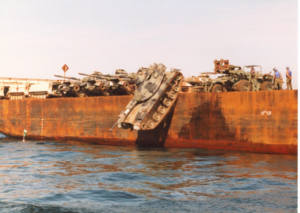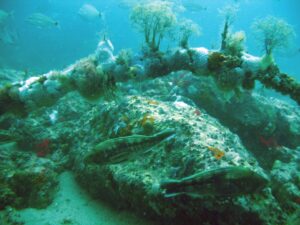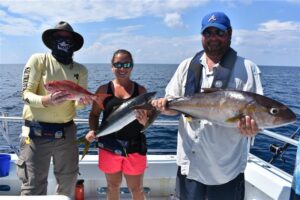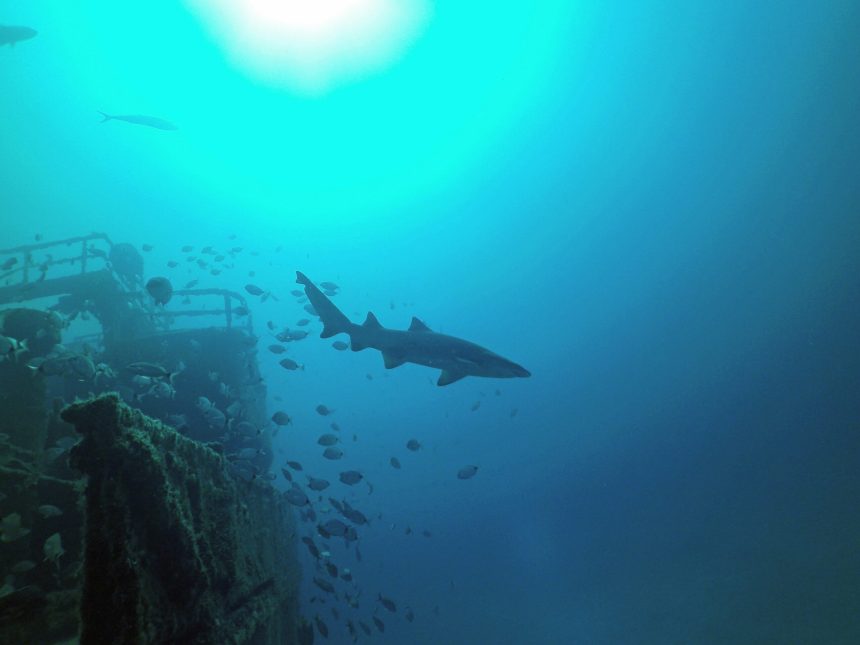By Cindy Sandoval, USFWS
Beneath the Atlantic surface, concrete pyramids, stripped subway cars, and massive steel skeletons of vessels lie purposefully placed across the ocean floor repurposed into bustling undersea metropolises. These are artificial reefs, human-made sanctuaries giving new life to marine ecosystems and new opportunities for anglers.
Nearly all of these reef structures have roots in the Sport Fish Restoration Act, paid by manufacturers of fishing tackle and a tax on motorboat fuel. State agencies utilize these Sport Fish Restoration federal excise tax funds and funds from state fishing license sales to create a network of artificial reefs that dot the Atlantic coast.
New Jersey: Reefs from Rust and Rubble

The New Jersey Department of Environmental Protection (NJDEP) began their artificial reef program in 1984 and has since created 17 artificial reef sites. Creating the reefs takes science, ingenuity, and often recycled materials. Artificial reef building materials have ranged from concrete reef balls to decommissioned New York City subway cars, and even retired Army tanks. Before entering the water, artificial reef materials go through a rigorous process stripping the material down to ensure no impact to water quality. Recycled building materials are inspected. Old Army tanks are stripped of fuel and oils. Subway cars lose their windows and wiring. What’s left is bare concrete or metal that is durable and colonizable by marine life.
Once these reef materials are deployed to the ocean bottom, Mother Nature wastes no time. Drop reef material, and within weeks, algae take hold. Months pass, invertebrates and fish begin to settle in. Within a year or two, the reef is real in every biological sense. “New Jersey’s reef sites are a hot spot for anglers with sportfish species like sea bass, porgy, tautog, and summer flounder calling the sites home,” said Pete Clarke from the NJDEP’s Artificial Reef Program.
New Jersey’s reefs are strategically located along the coast so that sites are within easy boat range of New Jersey ocean inlets making the sites accessible to anglers. Some reefs lay within two miles of the coast while others are 23 miles offshore offering users a variety of trip lengths and sport fish species to encounter. Reef communities can also vary depending on the season. “These reefs are important waypoints for migrating sport fish along the Atlantic Coast,” adds Clarke. Along this waypoint network of artificial reefs, it is common for state agencies to collaborate with other state agencies to share information or access to large reef building materials. “I know that an old New York City subway car utilized for a reef in South Carolina or concrete reef balls deployed in Delaware benefits the entire network of artificial reefs, ultimately it helps New Jersey’s reefs and anglers.”
South Carolina: Habitat on Shifting Sands

Down the coast, South Carolina has over 40 artificial reefs that attract red snappers, amberjack, and groupers. Creation of artificial reefs off the Palmetto State’s coast is especially important due to the relative lack of naturally occurring hard-bottom along that area of coastline. “The majority of the continental shelf off of South Carolina is covered with sand, less than 10 percent has the needed hardbottom for the formation of a natural reef community,” said Ryan Yaden, Artificial Reef Program Coordinator for the South Carolina Department of Natural Resources. This results in limited opportunities for anglers and leads to heavy use of the naturally occurring hardbottom areas along the coast. “The creation of artificial reefs reduces pressure on limited natural areas, boosts fish populations by creating a space for fish to feed and grow, and these reefs give anglers a wider range of areas to make use of for both trolling anglers and bottom fishing.”
Like in other states, South Carolina’s artificial reefs provide not only a place for angling but also provide important fisheries research opportunities. “A number of our reef sites started out as experimental, with funding from the Sport Fish Restoration Program, allowing us to run experiments on fishing pressure and migration,” adds Yaden.
A South Carolina Saltwater Recreational Fishing License is required to fish the state’s artificial reefs with some areas having regulations limiting fishing gear to hand-held hook-and-line gear or spearfishing gear which excludes commercial harvest from these areas.
Florida: Economics of Ecology
These artificial reefs support ecosystems, they also buoy economies perhaps nowhere more visibly than in Florida. Florida has deployed hundreds of artificial reefs off both its Atlantic and Gulf coasts. These reefs provide habitat for fish that draw in anglers and tourists by the millions. Artificial reefs in Florida contribute billions annually in economic output, supporting thousands of jobs in coastal communities. For bait shops and charter captains to hotels and seafood restaurants— these reefs are as vital as the tides.
“An artificial reef is not just a structure , it’s opportunity, economic opportunity and angling opportunities for residents and visitors,” said Keith Mille, administrator for the Florida Fish and Wildlife Conservation Commission’s Artificial Reef Program. Florida manages one of the most diverse, and most active artificial reef programs in the United States with over 300 reef sites state-wide. With funding through Sport Fish Restoration Act dollars and Florida saltwater fishing license revenues, the FWC Artificial Reef Program has distributed more than $26,000,000 for artificial reef related activities across the state. “These funds support the deployment of new reefs, research and monitoring of current reefs, and staff time to provide guidance and technical expertise for partner counties and cities,” adds Mille.
Beyond the economic boost there is another reward for Mille, full coolers and fuller stories. “These artificial reefs provide resident and visiting anglers with a connection to the ocean, when we create habitat, we also create opportunities for future anglers to land some of the most popular recreational fish in Florida waters.”
A Foundation for Fish and Anglers

As each reef takes root, rusty ships are turning into fish hotels and sand flats are blossoming with life. The coast is being quietly transformed—one structure, one fish, one fishing trip at a time. This, in turn, also creates a positive economic impact on coastal communities with businesses that cater to the many anglers utilizing the new reef areas. Thanks to the support through the Sport Fish Restoration Act and the dedicated state fish and wildlife agency staff these artificial reefs are creating real opportunities along the Atlantic Coast.

